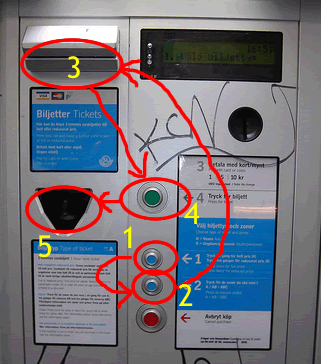This will be a field day for industrial designers and usability experts. The new ticket vending machines for the Stockholm public transport system have been met with a lot of criticism lately. People are finding them difficult to use and apparently there are very few tickets sold. On top of that they look like the machines seen in parking lots. Oh wait, they are apparently from the same manufacturer.
Stockholm public transport has a tradition of being late to the 21st century. Pre-paid tickets are still paper based and stamped by the bus driver. Previously you could buy them directly from the bus driver. However, robbery prompted the public transport authorities to remove all cash handling from the bus drivers, hence the increased need for outdoor ticket vending machines.
So, how do you interact with these machines?

- You start in the middle and press a blue button one to three times to tell the machine if you want a ticket for zone A, A and B or A, B and C.
- Move down and press the second blue button once for a regular ticket or twice for a reduced price ticket.
- Now it’s time to swipe your credit card on the top left side of the machine.
- Move back to the center and press the green button once.
- Ticket appears to the left.
Complaints mainly focus on the illogical placement of buttons (4, 1, 2 if you read top to bottom). In between pushing the buttons you have to look at the two line dimly lit LCD display to see what you are supposed to do next.
I am guessing most people buy a regular priced ticket for zone A (the city center). This involves pressing three buttons. Maybe the most common scenario could be reduced to “press a zone button and swipe your credit card”? Why does it have to be difficult?
I remember the pleasant experience of the Tokyo subway system. On some machines, all you did was to push a button representing your destination on the map, dump a fistful of coins into the machine and it would hand you the ticket and spare change in an instant.
Update: We won the World Usability Day design contest with a redesign of this machine. The design proposal and background is here (only in swedish).